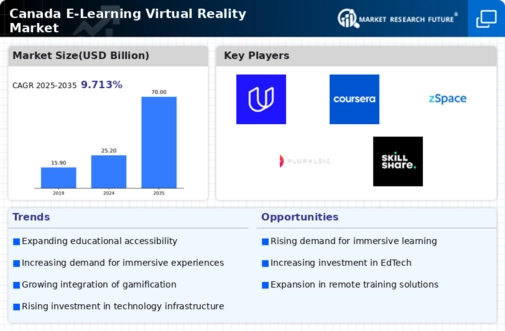Technological Advancements in VR
The e learning-virtual-reality market is experiencing a surge due to rapid technological advancements in virtual reality (VR) hardware and software. Innovations such as improved graphics, enhanced interactivity, and more affordable VR headsets are making immersive learning experiences more accessible. In Canada, the market for VR technology is projected to grow at a CAGR of approximately 30% over the next five years. This growth is driven by educational institutions seeking to integrate VR into their curricula, thereby enhancing student engagement and retention. As VR technology becomes more sophisticated, it is likely to transform traditional learning environments into dynamic, interactive spaces that cater to diverse learning styles. Consequently, the e learning-virtual-reality market is poised for significant expansion as educational stakeholders increasingly recognize the value of immersive learning experiences.
Government Initiatives and Funding
Government initiatives play a crucial role in the growth of the e learning-virtual-reality market. In Canada, various federal and provincial programs are designed to promote the integration of technology in education. For instance, funding for digital literacy programs and grants for educational institutions to adopt innovative technologies are becoming more prevalent. The Canadian government has allocated millions of dollars to support the development of digital learning resources, which includes VR applications. This financial backing not only encourages schools to invest in VR technology but also fosters collaboration between educational institutions and tech companies. As a result, the e learning-virtual-reality market is likely to benefit from increased investment and support, paving the way for innovative educational solutions that enhance learning outcomes.
Collaboration with Industry Leaders
Collaboration between educational institutions and industry leaders is emerging as a key driver for the e learning-virtual-reality market. Partnerships with technology companies enable schools to access cutting-edge VR tools and resources, fostering innovation in educational practices. In Canada, several universities are collaborating with VR developers to create tailored learning experiences that align with industry demands. These partnerships not only enhance the quality of education but also ensure that students are equipped with relevant skills for the job market. As the e learning-virtual-reality market continues to evolve, such collaborations are likely to become more common, driving the development of specialized VR content that meets the needs of various sectors.
Focus on Skill Development and Training
The e learning-virtual-reality market is increasingly focused on skill development and training, particularly in sectors that require hands-on experience. VR technology provides a safe and controlled environment for learners to practice skills without the risks associated with real-world scenarios. In Canada, industries such as healthcare, engineering, and aviation are adopting VR training programs to enhance workforce readiness. Reports indicate that organizations utilizing VR for training have seen improvements in knowledge retention rates by up to 75%. This emphasis on practical skill acquisition is likely to drive demand for VR solutions in the e learning-virtual-reality market, as companies seek to invest in effective training methods that yield measurable results.
Rising Demand for Remote Learning Solutions
The e learning-virtual-reality market is witnessing a rising demand for remote learning solutions, particularly in the context of evolving educational needs. As more learners seek flexible and accessible educational options, VR technology offers a unique solution that can simulate real-world experiences from the comfort of home. In Canada, the number of online learners has increased significantly, with estimates suggesting that over 30% of post-secondary students are now enrolled in online courses. This trend indicates a shift towards more personalized and engaging learning experiences, which VR can provide. By leveraging immersive environments, the e learning-virtual-reality market can cater to the needs of remote learners, enhancing their educational journey and potentially improving retention rates.

















Leave a Comment